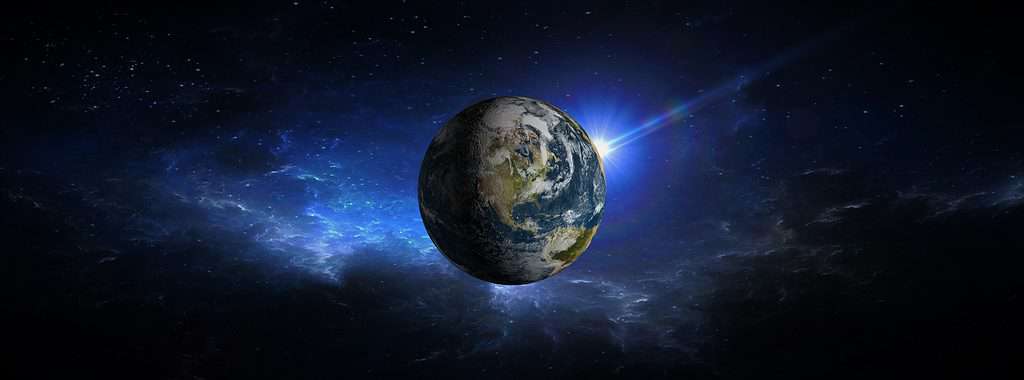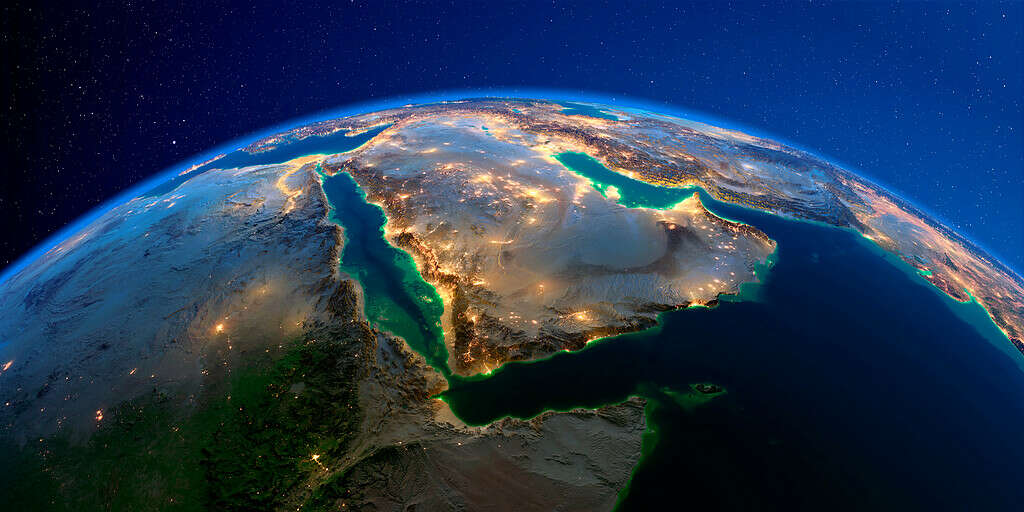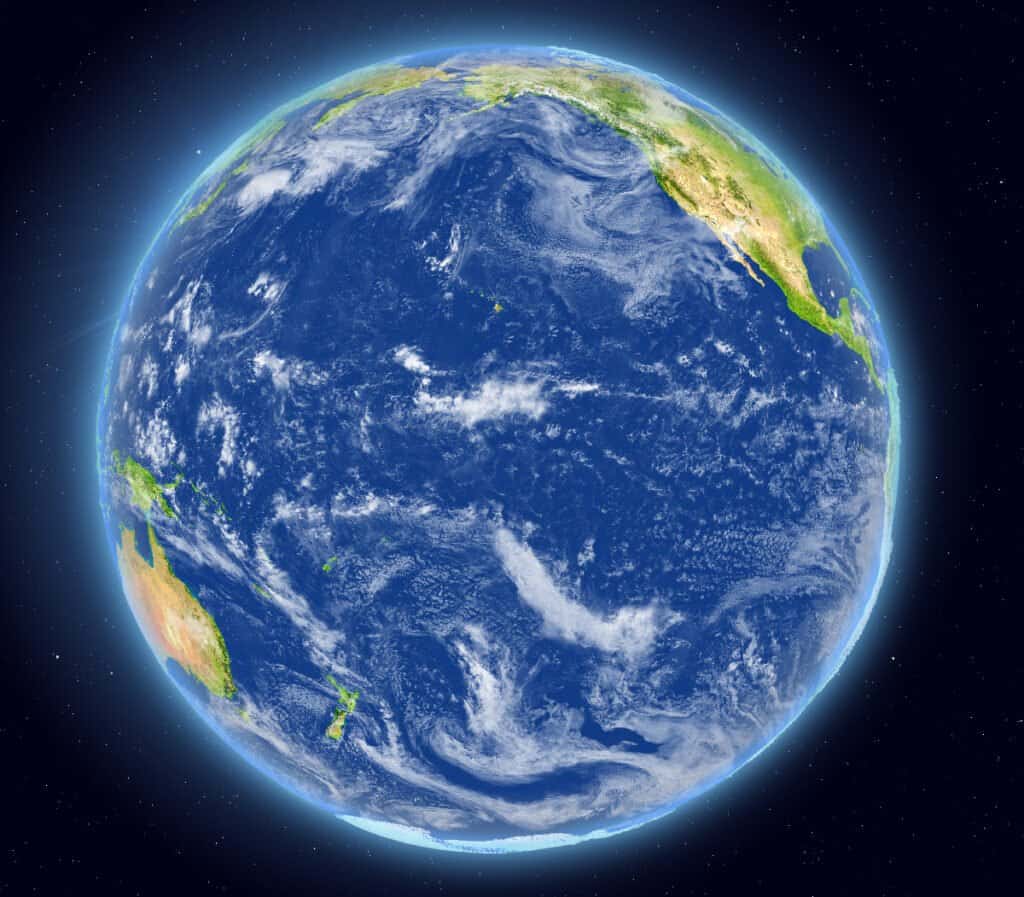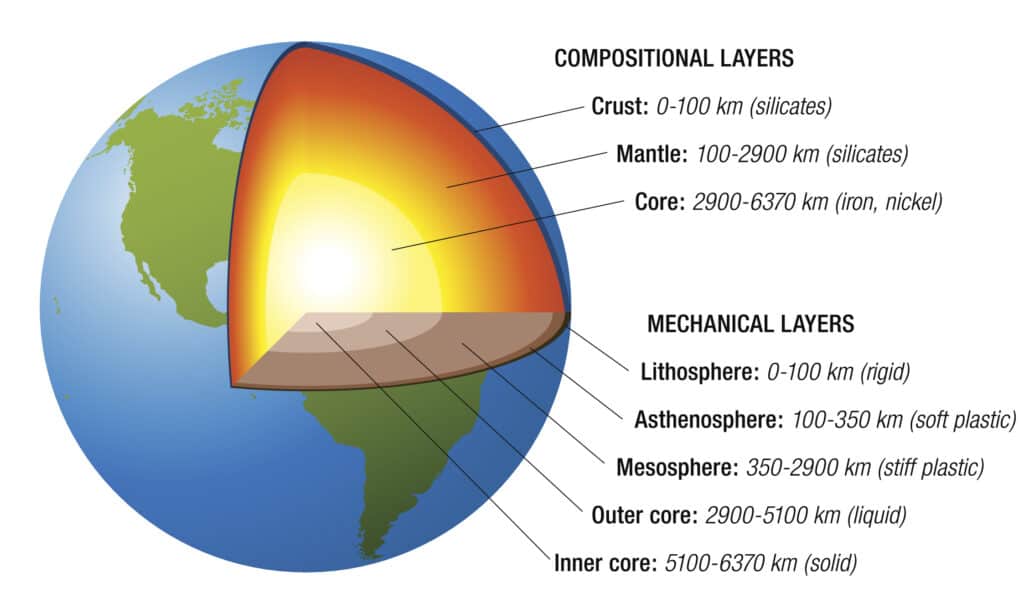The Earth’s size is one of the features that makes it the only life-sustaining planet in our solar system. The Earth’s mass, surface area, and diameter seem huge from our perspective as humans, but in comparison to the rest of the solar system, our planet is one of the smallest. Studying characteristics like this helps scientists better understand the planet’s structure, composition, and evolution. It allows them to think about what to look for in other potentially habitable planets around other stars. In this article, we will explore the Earth’s size and how it helps make life possible.

The Greeks understood the curvature of the Earth as far back as the 6th century B.C.
©SN VFX/Shutterstock.com
How Do We Know Earth is Not Flat?
First, let’s make sure we’re on the same page. We can’t take this for granted, because unfortunately, some poorly informed individuals have begun promoting the long-ago disproved idea of a flat Earth. The Earth is in fact a spherical object.
The Greeks understood the curvature of the Earth as far back as the 6th century B.C. when philosopher Pythagoras taught this idea. His student Parmenides argued that the Earth must be spherical because it casts a circular shadow on the Moon during a lunar eclipse (when the Earth passes between the Sun and the Moon). Aristotle said that the stars in the night sky move like they were rotating around a central point, showing the earth was a sphere. Ancient people could also observe that when sailing ships went over the horizon, their sails were the last part of the ship to disappear, indicating that there is a curvature to the Earth. You can see the curvature of the earth yourself by looking out the window of a high-flying airplane.
We also see that gravity pulls objects down to the ground, including people, from all parts of the planet, towards the center of its mass. Space travel has definitively proved the shape of the Earth, as we have launched thousands of satellites that orbit the planet and can be tracked, hundreds of astronauts have orbited and observed the planet with their own eyes and sent back video footage, and we have used the gravity of the Earth and other planets to “slingshot” spacecraft at high speeds to the outer solar system. None of this science and technology would work if the planet were not spherical.

The curvature of the earth seen from high altitudes and from spacecraft shows that it is a spherical object.
©Anton Balazh/Shutterstock.com
Earth’s Mass
The Earth’s mass is approximately 5.9742 × 1024 kg (1.31629 × 1025 lbs.), which makes it the fourth-largest planet by mass among the eight planets of the solar system (5th largest if you still claim Pluto). Most of this mass is made of the elements iron, oxygen, silicon, and magnesium. The planet’s core is mostly iron and nickel. The mass of a planet is what determines the strength of its gravity. That’s important for life on Earth because the gravity here is strong enough to keep our vital atmosphere from drifting off into space, without being so strong that we are crushed down to the surface and unable to function. Mars, a much smaller planet, is an example of a celestial body that did not have enough gravity to hold onto its atmosphere.
Gravity also determines your weight on different planets. If you’d like to find out what you would weigh on the largest planet in the solar system, check out this article: This Is How Much You’d Weigh on Jupiter. (We don’t have an article like that about how much you would weigh on Earth: for that just step on a scale!) Check out the chart below to compare the mass of the Earth with other planets, the dwarf planet Pluto, and the Sun.
Earth’s Mass Chart
| Mass | Number of Earths | |
|---|---|---|
| Sun | 1.988435 × 1030 kg 4.38442 × 1030 lbs | 333,000 |
| Jupiter | 1.899 × 1027 kg 4.18658 × 1027 lbs | 317.8 |
| Saturn | 5.6846 × 1026 kg 1.25361 × 1027 lbs | 95.2 |
| Neptune | 1.0243 × 1026 kg 2.25858 × 1026 lbs | 17.1 |
| Uranus | 8.6832 × 1025 kg 1.913839 × 1026 lbs | 14.5 |
| Earth | 5.9742 × 1024 kg 1.31629 × 1025 lbs | 1 |
| Venus | 4.8685 × 1024 kg 1.07323 × 1025 lbs | 0.815 |
| Mars | 6.4185 × 1023 kg 1.41469 × 1024 lbs | 0.107 |
| Mercury | 3.302 × 1023 kg 7.27923 × 1023 lbs | 0.0553 |
| Pluto | 1.305 × 1022 kg 2.87769 x 1022 lbs | 0.0022 |

The mass of the Earth ranks as the fourth largest among the eight planets of the solar system.
©iStock.com/buradaki
Earth’s Surface Area
The Earth’s surface area is approximately 5.100656 x 108 km2 (1.96907 x 108 mi2), divided up as 30% land and 70% water. One reason this is significant for life on Earth is that it affects how much solar radiation is absorbed, and how much is reflected back into space. Water itself is highly reflective but big oceans also evaporate and make a lot of clouds that reflect sunlight away from the planet to keep it from overheating.
The Earth’s surface is divided into tectonic plates that float on the molten magma of the mantle. When they rub against one another they create earthquakes, volcanoes, mountains, and rift valleys. At our human scale, the topography of the earth looks like it varies greatly, with towering mountains, deep canyons, plains, oceans, and sub-oceanic trenches. Although it is not true that the Earth would be smoother than a billiard ball if it were shrunk, even its most rugged features like the Himalayas would be barely noticeable. The surface area of the Earth is 5.100656 x 108 km2 or 1.96907 x 108 mi2. It is the fourth-largest full planet in the solar system.
Surface Area Chart
| Surface Area | Number of Earths | |
|---|---|---|
| Sun | 6.07877 x 1012 km2 2.34613 x 1012 mi2 | 11,917.607 |
| Jupiter | 6.1419 x 1010 km2 2.36886 x 1012 mi2 | 121.9 |
| Saturn | 4.27 x 1010 km2 1.64727 x 1010 mi2 | 83.7 |
| Uranus | 8.1156 × 109 km2 3.13355 x 109 mi2 | 15.91 |
| Neptune | 7.6408 x 109 km2 2.94723 x 109 mi2 | 14.98 |
| Earth | 5.100656 x 108 km2 1.96907 x 108 mi2 | 1 |
| Venus | 4.60 x 108 km2 1.77699 x 108 mi2 | 0.902 |
| Mars | 1.44798465 x 108 km2 0.55831 x 108 mi2 | 0.284 |
| Mercury | 7.48 x 107 km2 2.88617 x 107 mi2 | 0.147 |
| Pluto | 1.67 × 107 km2 0.6445 x 107 mi2 | 0.035 |

70% of the Earth’s surface is covered in water. Water, and the clouds that form over it, are highly reflective.
©Harvepino/Shutterstock.com
Earth’s Diameter
The Earth’s diameter is 12,756 km (7,926.39 mi), which is the fourth largest of the eight planets of the solar system. What would you find if you could take a cross-section of the earth at the equator? It would look like a target. At the outside is the crust, which is a 5-70 km thick layer of solid rock with continents and oceans on its surface. The next ring of the target is the mantle, which extends from below the crust down another 2,000 km. It’s made of semi-molten hot rock. At the center is the core, which is divided into two zones. The outer core is about 2,300 km thick and made of liquid iron and nickel. In the very center of the Earth is a solid ball of iron and nickel called the inner core, which is about 1,200 km across.
One of the reasons the core of our planet is so crucial to life on Earth is that the rotation of the core produces a magnetic field that extends around the planet and protects it from solar radiation and cosmic rays. The moon does not have a magnetic field, so astronauts and future colonists who go there to live and work will need living habitats, vehicles, and spacesuits specially designed to protect them in a high-radiation environment. By driving plate tectonics, the interior of our planet also creates new land and releases volcanic gasses that affect the chemical composition of our atmosphere. These are also important processes for the continuation of life on Earth.
Diameter Chart
| Diameter | Number of Earth Diameters | |
|---|---|---|
| Sun | 1,392,700 km 864,938.31 mi | 109 |
| Jupiter | 142,800 km 88,750.04 mi | 11 |
| Saturn | 120,660 km 74,981.31 mi | 9 |
| Uranus | 51,118 km 31,748.12 mi | 4 |
| Neptune | 49,528 km 30,788.25 mi | 4 |
| Earth | 12,756 km 7,926.39 mi | 1 |
| Venus | 12,104 km 7,523.06 mi | 1 |
| Mars | 6,779 km 4,214.39 mi | 0.5 |
| Mercury | 4879.4 km 3,031.35 mi | 0.33 |
| Pluto | 2,376.6 km 1,477.61 mi | 0.185 |

The rotation of the Earth’s core produces a magnetic field that protects the planet from cosmic radiation, which would make life impossible.
©iStock.com/PeterHermesFurian
A Train Through the Center of the Earth?
Well, here’s a question you probably aren’t asking, but we’re going to tell you the answer: could we build a train through the center of the Earth? The 2012 film Total Recall illustrates the concept. Passengers sit in a massive train that is dropped into a tunnel built straight down into the ground in Australia. Gravity pulls the train toward the Earth’s core, building up enough momentum to accelerate the train on the other side of the core until it comes to a stop on the other side of the planet, in London. If there were no friction, the whole system would not even require an energy source, as the laws of physics would do all the work. And even though Earth is HUGE, the trip would only take 45 minutes.
The idea of a so-called “gravity train” isn’t new. It was proposed by a British scientist as far back as the 17th century and studied as a possibility by French researchers in the 19th century when proposals for grandiose tunnel-building were in vogue. The American physicist Paul Cooper published a serious article about it in the 1960s. But would it really be possible? The answer is both yes and no. Yes, the mathematics of it work, but no, we do not have any building material or construction method that could do it.
Soviet Hole
In the 1970s, the Soviets dug the deepest hole in human history. The Kola Superdeep Borehole went down 7.5 miles, about a third of the way through the Earth’s crust. Even though it was only 9 inches wide, it took almost 20 years to reach that far. The temperature at the bottom was 180 °C (or 356 °F). It might sound hot, but it’s really very cool compared to the deeper parts of the Earth. The mantle gets up to 3700°C (6692°F), and the core temperature soars all the way to 5,200° Celsius (9,392° Fahrenheit). That’s actually far hotter than the surface of the sun and far more than the melting point of every known metal.

A Soviet stamp celebrates the Kola Superdeep Borehole.
©kola-kola/Shutterstock.com
The deepest point on Earth humans have ever visited is the bottom of the Mariana Trench. They had to travel in a specially-built submersible that would not be crushed by the pressure of the ocean all around them. The pressure at the center of the Earth would be exponentially higher, and probably an even more difficult problem to overcome than the heat. How could we build a tunnel that could withstand that? And that’s not even considering the fact that the liquid and semi-liquid levels of the Earth’s interior are constantly in motion, so it would be hard to hold any kind of permanent structure rigidly in place so that the tunnel would not be sealed off or moved from its intended starting and ending points.
So for now, it looks like we’re limited to digging tunnels through the Earth’s crust. Check out this interview with celebrity astronomer Neil deGrasse Tyson for an explanation of the whole concept:
A “Goldilocks” Planet
In the fairy tale “Goldilocks,” a little girl does a home invasion of a bear family’s home, systematically breaking their furniture and eating their food looking for things that are “just right” for her. We humans, too, are on the lookout for planets around other stars in the “Goldilocks zone” – that is, in the optimal range for human life. To find that, we have to look not only at how far other planets are from their stars, but at characteristics related to the size of the Earth, like mass, surface area, and diameter.
Each of those characteristics protects Earth in different ways, determining the level of its gravity and its ability to hold on to an atmosphere, to the way it protects us from radiation with a reflective water and cloud surface, to the levels, composition, and movement of the interior of the planet that provide protective magnetic field and plate tectonics that have helped create land surfaces and determine the composition of our atmosphere. Now let’s just hope if we visit any of those planets, we don’t mess them up . . . or tick off any equivalent of space bears we may find there.
The photo featured at the top of this post is © Dima Zel/Shutterstock.com
Thank you for reading! Have some feedback for us? Contact the AZ Animals editorial team.







